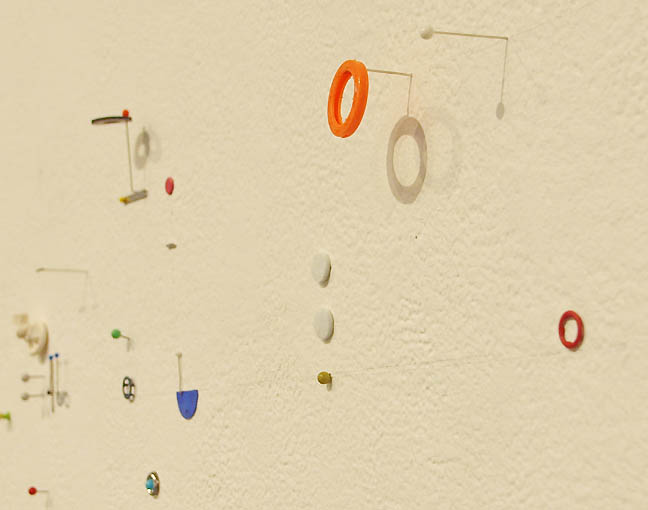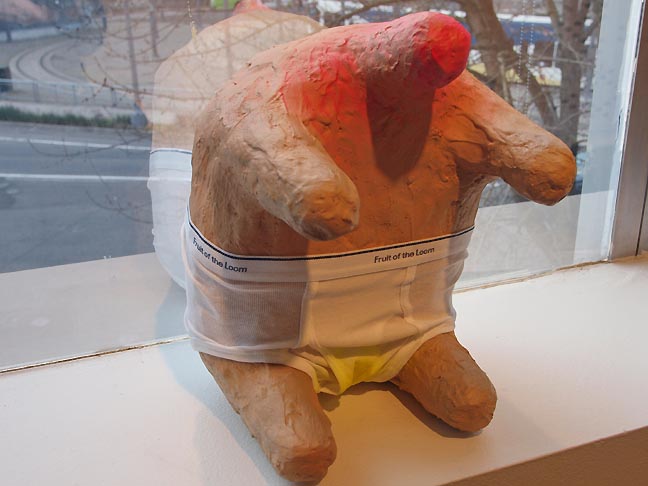
|
||
|
Portland art blog + news + exhibition reviews + galleries + contemporary northwest art
|
||
Last Words: Portland's Visual Art Scene in 2013 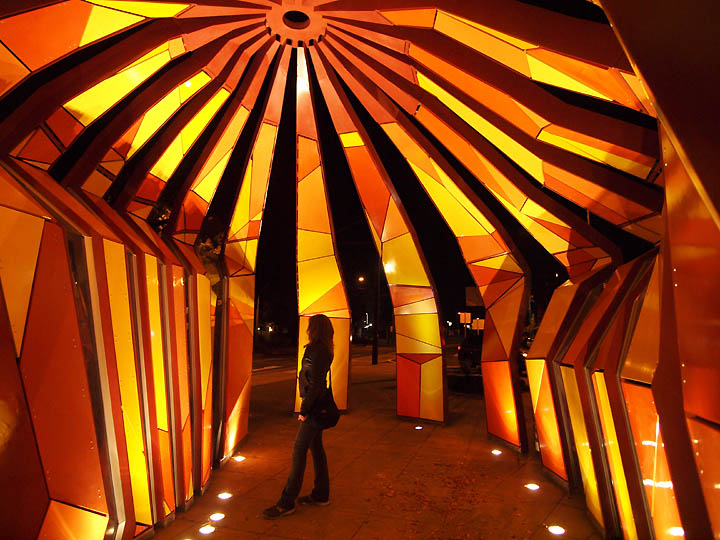 Jorge Pardo's Streetcar Stop for Portland (detail inside at night), Best Installation 2013 (all photos Jeff Jahn) Complacency is a state of mind that exists only in retrospective: it has to be shattered before being ascertained. -Vladimir Nabokov Portland's art scene was incredibly active in 2013 so I wouldn't describe it as year defined by complacency but like some aspects of 2012, specters at the institutional level still linger (mostly a divide between too much interest in old regional stereotypes to the exclusion of an immense influx of more varied and internationally relevant work). Still gains were made, such as when RACC changed their grant language to invite independent curatorial projects and new media to apply for project grants. The other fact is that Portland's living art scene still remains a meritocracy largely underinfluenced or spoiled by the art market. Since Portland is both small and hot in terms of international interest, complacency should be our chief area of concern. Do we support what we already know better than what challenges us? I counter that criticism is a cure for complacency, and by that I mean real criticism... not the kinds that merely flatter and reiterate artists statements as a kind of marketing for friends, community support and favored galleries or simple rants. I'm writing specifically about criticism that expands the discussion and illuminates the pressure points, right or wrong it matters not as long as there is informed intellect and integrity at work. Criticism will ruffle feathers (even when positive) and cannot be expected to go down any smoother than the visual art can be expected to. Practicing this type of criticism is an earned errand and 2014 marks my 15th year in the city. I've perhaps directly provoked and pushed the city's expectations and championed/seen more new art exhibitions than anyone else within city limits can claim in that period, but it is being a talent scout and facilitator that I enjoy the most. The other stuff is mostly done because it needs to be done or said. Portland is a city that has trouble with ascertaining scope and scale. That aspect keeps it permissive but that means it can also ignore its strengths and weaknesses in the cause of gemutlichkeit. Criticism requires a certain testing and unsettling of presuppositions. 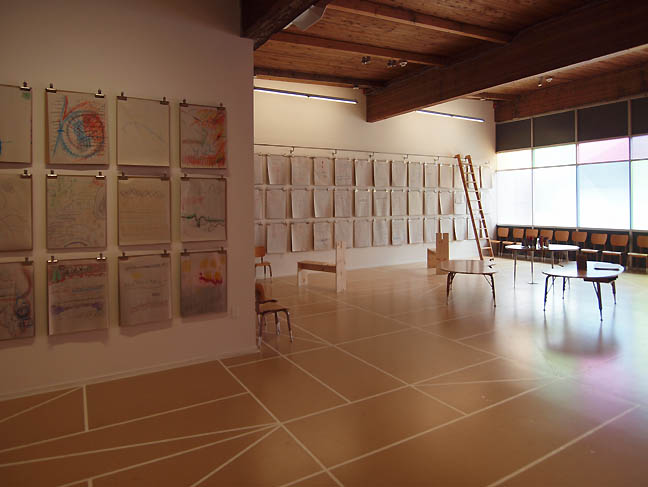 Anna Craycroft's C'mon Language at PICA PORT achieves that tension, when much of Portland likes to reduce everything to a dinner party. As a small city Portland is in danger of becoming cliqueier and since clique dynamics are more defensive they risk becoming narrowly celebratory rather than insightful pockets of innovative ideas, which I am also very quick to point out. Defensiveness is a hallmark of regionalism at its worst. Thing is, in a place as internationally active as Portland everyone should take pains to avoid defensiveness as a first reflex, especially amongst curators and other arts administrators. I care about this place but don't mistake my high standards for anything other than an allergic reaction for settling at the middling level that cliquishness tends to enforce. 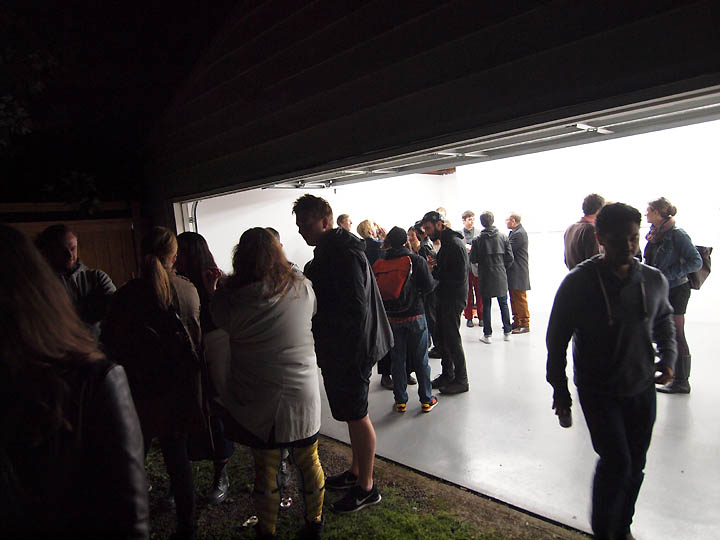 The final opening at Appendix, October 2013 Good thing that Portland is perhaps the hottest city in the United States and as such many of its strongest and most interesting artists did their best work in 2013 in places beyond Portland's city limits. Storm Tharp had a retrospective at Cornell's Johnson Museum, Damien Gilley did well in Seattle at Suyama Space, Avantika Bawa showed in Toronto, MK Guth in Denmark, Laura Fritz at the prestigious Des Moines Art Center (one of the best contemporary only art museums, interview here), James Lavadour at the Venice Biennale, Brenna Murphy took it to Germany, Alex Mackin Dolan in London, Modou Dieng at Brooklyn's The Museum of Contemporary African Diasporan Arts and Corey Arnold seemed to be everywhere all of the time. That list is representative of just a few moments where Portland's scene but it reiterates my description of Portland as a rebel base for artists.... if you don't let the complacency of regional tropes like emphasizing hand crafting over concept and experiential rigor or focusing far too much on where you teach over your work then you can make a dent in the international art world, while enjoying Portland's non-corporate yet stimulatingly permissive density of artists and open minded people. Just don't get caught up in the petty cliquey aspects, that's a direct warning to Portland's curators, dealers and patrons as well, not just the artists. PORT has a massive international audience for an art site in Portland, breaking over 1.3 million unique readers this year alone, which also helps makes us the top site for information on Portland art on the Internet. It was our best year ever. Our top article's reflect our role as the chief interchange between Portland's local visual art scene and the world's. Here's the list (articles from previous years omitted): 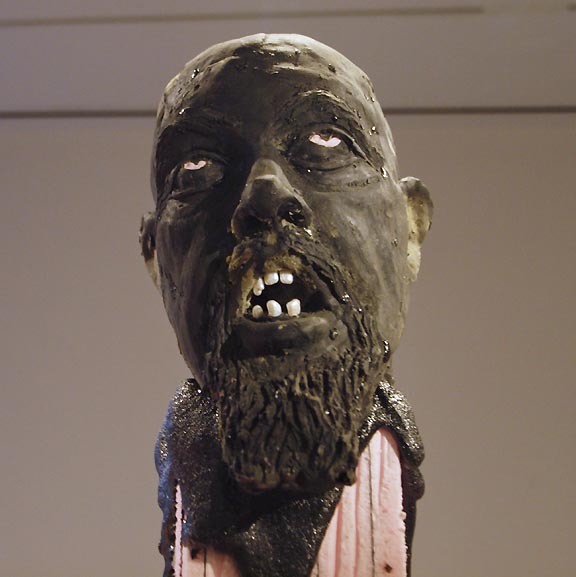 Detail of Folkert de Jong's Operation Harmony at PAM #1 my highly critical review of Folkert de Jong's disturbing exhibition at the Portland Art Museum. Whether you liked it or not this show was provocative. #1 always turns out to be a surprise. #2 A probing and critical interview with architect Kengo Kuma regarding his planned addition to Portland's Japanese Garden #3 I correctly predicted when Jeffrey Deitch would be leaving MOCA, we were also the among the first handful of sites on the internet to have the story when it occurred a few weeks after June 30th. #4 Tori interviewed the Critical Art Ensemble on the occasion of their their Feldman Gallery exhibition. #5 Interview with Jorge Pardo about his first public art project in the USA, his quixotically titled Streetcar Stop for Portland (it isn't a shelter, it is art). #6 When everyone else lost their heads when the Francis Bacon came to PAM, I talked some sense... when others saw dollar signs and couldn't comprehend it as an excellent work unto itself. It is one of his best suite of works.  #7 We should name Trimet's new transit and pedestrian bridge after Mark Rothko because his biography is indelibly tied to that area of Portland (no opinion can modify this key historical fact). Also, Rothko had an affinity for bridges and endured the kind of racism Russian Jews fleeing oppression did in those days so charges of him being just another dead white man are not accurate. Lastly, Rothko repeatedly painted this area of the Willamette River and is Portland's most famous son... a fact many old school Portlanders expend incredible amounts of energy trying to deny. Newer Portlanders know him as an immigrant, destined to be on the outside of Portland's waspish mainstream, who later achieved greatness beyond regional notables and it resonates with us. Greatness is a bridge... #8 The inaugural Hallie Ford Fellows exhibition highlighted many local issues... like poor exhibition design, too many of the same names who are regional favorites but not internationally worthy and a conservative anti-new media approach. Soon after, the next round countered by picking some artists who are making their best work and one new media artist that they tried to dress up by intoning craft... #9 We broke the story on how The Precipice Fund sought to redress gaps in funding for more difficult to classify projects. #10 The Oregon Arts Commission is likely in the midst of a State level shakedown with Christine D'Arcy gone... but they took note that so many surveys and awards overwhelmingly favor white men and made a corrective statement with their visual arts fellowships for 2014. Other great articles by other PORT writers you should check out: Victor's review of a group of important Sigmar Polke's at PAM, Amy's interview with the Curator of the Noguchi Museum Tori's interview with Anna Craycroft Well will miss: Kartz Ucci and Walter de Maria RIP and Appendix... and though I feel like we rarely saw eye to eye Terri Hopkins stepped aside as director of the Art Gym (she always felt like a holdover for old Portland to me, which is not a bad thing). Hard work is rarely appreciated enough here and she deserves credit for passing a torch on a high point after the space was renovated. 2013 Year End Awards: 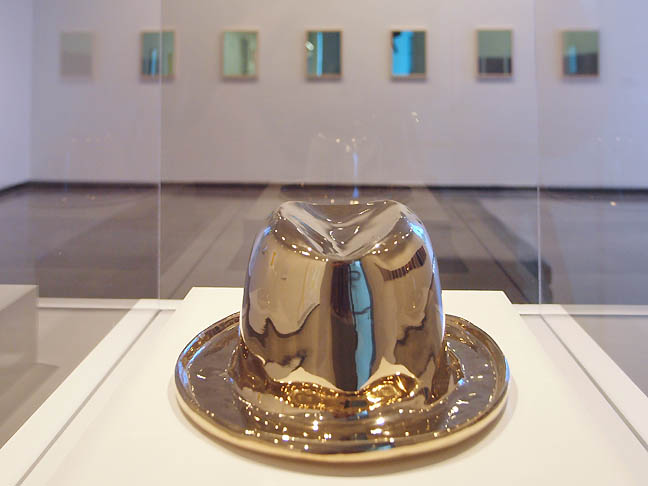 Sherrie Levine at PAM Best installed show: Sherrie Levine at PAM, so many exhibitions try to do this referential material work but Levine's mirrors and color coded Monet with a brass Beuys hat was several levels above the fray and was perfectly installed so that they reflected each other, seemingly to caricature the museum experience in a way that was insightful and not just an MFA level institutional critique. Mike Rathbun at The Archer Gallery deserves honorable mention as does Suzanne Opton, whose photography of veteran's portraiture at Linfield was also perfectly installed. Welcome Back Cotter: Did anyone else notice how much more engaged and inviting PNCA seems with MK Guth running the MFA program again? Lots of people did, especially at the Ann Hamilton lecture's introduction. It is only a temporary thing but perhaps they should consider someone who shares MK's Midwestern enthusiasm and utter lack of passive aggressive behavior that seems to be rampant in art schools on both coasts. 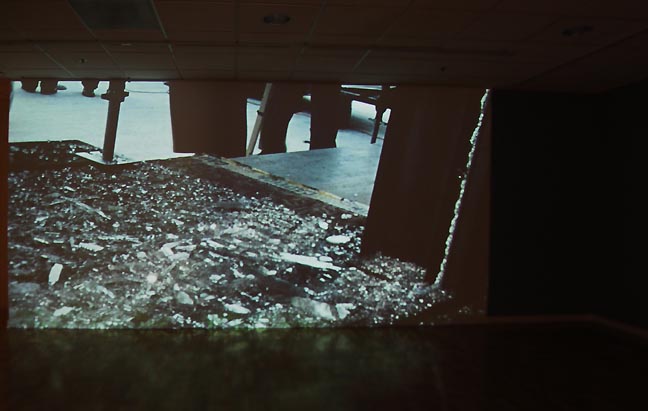 Inigo Manglano-Ovalle's Always after the Glass House at PSU's Littman Gallery (April 2013) Gallery of the Year: PSU's Littman Gallery. With a heavyweight anchor like Inigo Manglano-Ovalle and the 2013's most adventurous series of shows including Derek Bourcier, Bits and Pieces, Tori Abernathy, Jane Schiffhauer and Blair Saxon-Hill, this gallery was always well installed and full of surprises. The fact that it was programmed by 2 different teams of students for the two school years that made up 2013 only makes it more impressive. Old stalwarts like the Cooley Gallery and the Art Gym did not compare and William Pope L. is coming up next in 2014. With spaces at Linfield College, Pacific University and PCC Sylvania now also regularly doing great shows it has really upped the ante for University spaces to do relevant work. Upfor Gallery as a new commercial gallery is certainly doing things we haven't seen since NAAU closed in 2011. Best Video Installation: Inigo Manglano-Ovalle's Always After The Glass House at PSU's Littman Gallery, simultaneously honoring and demolishing Mies Van Der Rohe this piece was the most compelling video work on display in Portland for 2013. I enjoyed Pander and Lucas's video Incident Energy but it seemed too long and could have been edited for greater effect as figures began to be shown in the wilderness, still it has a lot of visual oomph. Ann Hamilton's video installation of tall ships in the back of Elizabeth Leach Gallery were wonderful as well. Strongest Group Show: held over from 2012 Fighting Men at Lewis and Clark College was tough to beat. Bits and Pieces at the Littman gallery also deserves mention. I also enjoyed 12128's Dumb Angel. New Kid on the Block: Upfor, with only 3 shows they are first gallery to look like it is truly representative of Portland's scene in years. Honorable Mention, Eutectic gallery's focus on clay fills an important gap. Photography Exhibition of the Year: It can only be Portland raised Carrie Mae Weems who received a MacArthur genius award after her exhibition at the Portland Art Museum. It travels next to the Guggenheim in New York. Honorable Mentions: Robert Adams also at PAM (curator Dolan had a great year) and the intriguing Chuck Close tapestries at Bluesky made me like Chuck close a great deal more than I have in the past decade or two. Best Installation Art: Jorge Pardo's Streetcar Stop for Portland... and it it is on view 24/7/365 days a year. Honorable mention goes to Brenna Murphy's Lattice~Face Parameter Chant at Upfor was exceptional though its second iteration Liquid Hand felt gimmicky. Mike Rathbun at The Archer Gallery really made something worth seeing in Vancouver, also one of the year's best shows. Taking it to school: PICA may have left the school grounds for 2013's TBA but Anna Craycroft's exhibition/school C'mon Language at PICA's HQ felt like an extended summer school session, almost as if PICA wanted to take the last 4 years at Washington High School with them back to downtown Portland... or at least exercise its memory. Nice touch leaving it as a inactive shell in September during TBA, that's curator Kristan Kennedy reflexively cross-critiquing her own show's almost sickening community joiner fetish aspect. Obviously, Kristan can handle the critical feedback and doesn't need anyone's misplaced attempts to defend her choices. (We do compare notes more than ever these days and the gloves are always off). Overall, what's with this intense fetish with going back to the classroom? Another exhibition of Josiah McElheny projects at the Lumber Room was perhaps the most oddly academic exercise of the year. That isn't to say it was bad but it was perhaps the most arid sampler of that excellent artist's work, ever. Craft is not Kraft: Brad Mildrexler at Eutectic Gallery. This work isn't some self-conscious argument for ceramics as art, it just is. Brad's work has this intense sense of existential persistence, not exactly man-made because they lack that house proud self-consciousness I often see in this kind of work. Instead, he's a bit of a geologist/witchdoctor combo. Best Print Show: Daniel Duford at Nisus Gallery. Daniel is a smart guy but his work often seems like it is making too many obvious attempts to ingratiate itself to its audience but this show of raw woodblock prints pasted directly on the wall was self assured and challenging. Curating Fighting Men may have really helped him. Always good to see. 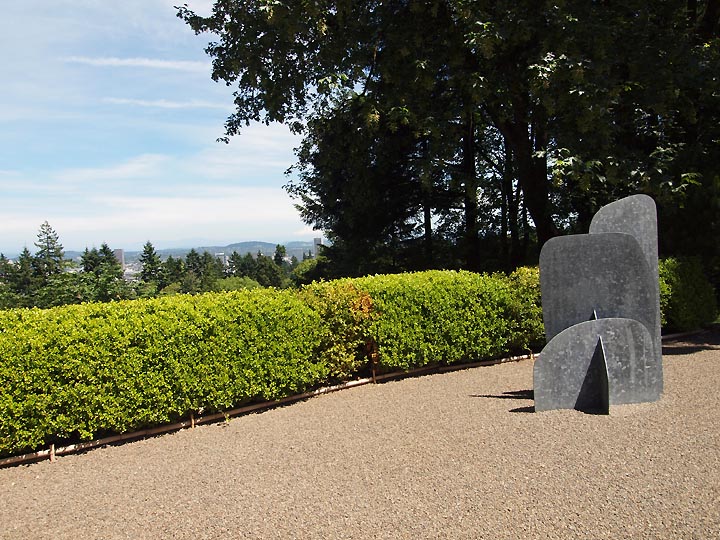 Noguchi at the Japanese Garden Best Sculpture: Isamu Noguchi at The Portland Japanese Garden was a once in a lifetime treat and being able to see works from the Noguchi Museum in the garden context to celebrate their 50th year was easily one of the highlights of the year. The pairing of Fred Sandback and Julia Dault deserves notice too, Sandback is nearly always a quiet revelation and thankfully Dault's work wasn't in the same room (it is good but not THAT good, very little is... well, Noguchi is). I found the Lucy Skaer show at YU to be derivative of Michael Heizer and why must every show there be related to printing presses? Another show that deserves mention was Cynthia Lahti's Elsewhere at PDX Contemporary had a wry wit combining sculpture and found photography in inspiring ways. . Posted by Jeff Jahn on January 01, 2014 at 18:45 | Comments (0) Comments Post a comment Thanks for signing in, . Now you can comment. (sign out)
(If you haven't left a comment here before, you may need to be approved by
the site owner before your comment will appear. Until then, it won't appear
on the entry. Thanks for waiting.)
|
| s p o n s o r s |
 |
 |
 |
 |
 |
 |
 |
 |
 |
 |
 |
 |
 |
 |
 |
 |

|
Site Design: Jennifer Armbrust | • | Site Development: Philippe Blanc & Katherine Bovee | |


